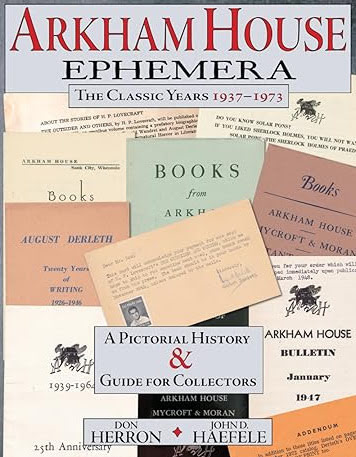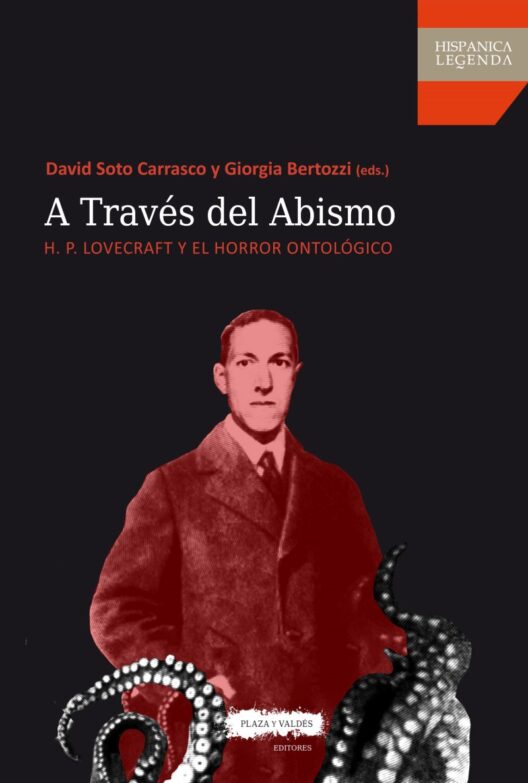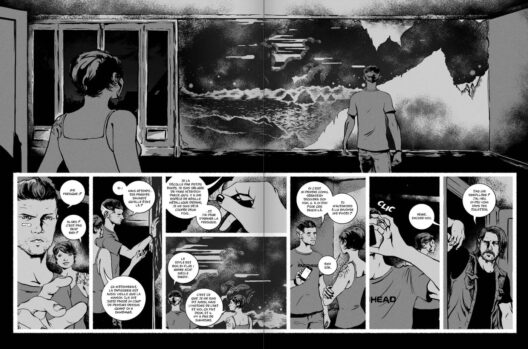Welcome to HPLinks #12.
“Little Bobby Barlow, for all his scant 16 years, can remember a world & a phase of civilisation — the feverish, thoughtless, reckless age of the 1920’s — which is today as dead as Tyre & Babylon!” — Lovecraft letter to Toldridge, March 1935.
* Now published, Arkham House Ephemera: The Classic Years 1937–1973 (October 2024)…
The story of [the early Lovecraft publisher] Arkham House told in the ephemera is no less than the personal autobiography of the press. Year by year and sometimes month by month, see plans unfold — always to publish more books to keep readers and collectors coming back. In this ‘Pictorial History and Guide for Collectors’ each individually numbered item spotlights a shot of the cover or distinguishing interior feature. In full color. With additional selected information, so that any item can be recognized easily from any other.
* This week John Coulthart blogged on “Richard Taylor’s Lovecraftiana”, Taylor being the artist Derleth tapped for the dust-jackets of various Arkham House books.
* Talking of covers, I’d never until recently seen the cover of this 1983 Polish translation of Lovecraft. The unknown artist has made a pleasingly loose sans-Cthulhu combination of the broken ground of the risen R’lyeh, the mind-bending portal-door found there, and a cosmic sky-vista.
Unlike many cover artists, it appears he had actually read and considered the story he was illustrating…
… everyone watched the queer recession of the monstrously carven portal. In this phantasy of prismatic distortion it moved anomalously in a diagonal way, so that all the rules of matter and perspective seemed upset. The aperture was black with a darkness almost material. That tenebrousness was indeed a positive quality; for it obscured such parts of the inner walls as ought to have been revealed, and actually burst forth like smoke from its aeon-long imprisonment, visibly darkening the sun as it slunk away…” (“The Call of Cthulhu”).
* New in The European Conservative, the article “Rebuilding R’lyeh: Houellebecq, Lovecraft, and the Meaning of Architecture”. Freely available online.
* A 2023 Brazilian post-graduate thesis, O horror cosmico de H.P. Lovecraft como expressao da barbarie do mundo administrado (‘H.P. Lovecraft’s cosmic horror as an expression of the barbarity of the administered world’). Freely available in PDF here, with an English abstract. The work examines…
relations between the aspects of form and content used by [Lovecraft] and the forms of control and domination of nature marked by technological rationality, barbarism, and fear, characteristic of the living conditions found in the administered [i.e. bureaucratic] society. The main themes [found were] criticism of the occult; of the regression to barbarism in the context of war; the constitution of authoritarianism through patriotism; war neuroses; the disappearance of the intellectual type; the formation of sects and fanaticism; and the notion of imminent threat of the end. [Lovecraft] explores, through fear, the path of regression of society and the submission of its members to disastrous ideas and policies, as well as an attack on narcissism through the exploration of the sublime. In this way his work allows contact with fears that, if brought to consciousness and reflected upon, may reduce their harmful effects on the individual [reader’s psychological] formation process.
* From Spain, the new 2024 multi-author academic book A Traves Del Abysmos: H.P. Lovecraft y el horror ontologico (‘Traversing the Abyss: H.P. Lovecraft and ontological horror’).
This chunky book costs a very reasonable 19 Euros from Amazon Spain. Had this been in English it might have been locked away at £120, by a big academic publisher aiming at a few hundred sales to academic libraries. It’s thus cheap enough to cut off the spine, scan to OCR and then auto-translate, if you needed to see it for your thesis etc. I have the contents pages auto-translated to English (the nice font and typesetting is lost), and here’s a translation from the blurb…
[Lovecraft resists] classification or explanation on a purely theoretical level. [He takes us] beyond the limits of what is human, making his literature a privileged threshold from which the most radical issues of philosophical reflection [can] emerge. The unknown relationships of time, space and matter; contact with extratemporal non-entities; the breakdown of existential certainty; the abyssal descents; the antediluvian languages; scientific revelations incompatible with what is human; the dream materialisations. Lovecraft [becomes] an extracosmic magma that flows though and illuminates the intricate network of the tensions running throughout modernity. Lovecraft’s manifestated ideas have permeated contemporary thought, prompting an important segment of thinkers to reflect on the unthinkable, talk about the unnameable and peer into the radical exteriority that surrounds the human world.
* The National Review magazine on “The Call of Lovecraft” ($ paywall). Possibly just another Halloween clickbait re-hash, of no interest to Lovecraftians? It’s difficult to know without seeing all of the article.
* Helios Press has announced a pre-order for a new expanded edition of The Gentleman from Angell Street. 140 pages in hardcover, compared to 70 pages in the previous paperback. I’m uncertain if it will contain the supposedly extant correspondence between HPL and the Eddys said to date “as early as 1918”, the existence of which was claimed many years ago by one of the Eddy descendants (see Joshi’s I Am Providence, page 465). But which was apparently not even shown to Joshi, and has never since been revealed. The blurb for the new edition does claim it will have new… “correspondence between and related to the Eddys and Lovecraft”. But that sounds to me like it could be letters sent ‘between the Eddys’, plus letters ‘related to Lovecraft’ — such as Clifford Eddy’s 1966 letter about Lovecraft (‘Knew Lovecraft’) which was published in The Providence Journal. That 1966 letter was not in the earlier edition. But all this is just my guess, based on the probability that, if we were to get actual new Lovecraft letters to the Eddys, then a lot more fuss would be being made about it in the blurb. I guess we wait and see. The book is due in 2025.
* Les Navigateurs, a new French ‘BD’ graphic novel by Caneva & Lehman. I see some good reviews, and apparently Lehman is a Lovecraftian who has made this book into a ‘Lovecraft in Paris’ tale. At least according to Marianne.net, which describes it as… “Lovecraft meets the waters of the Seine river”.
The preview pages make it look quite gritty-indie. And even less encouraging is the opening multi-page slog through some domestic teen-angst. Yet there is one page which hints the story may become more Lovecraftian later on…
* Veteran European comics publisher Humanoids plans to revive its venerable Metal Hurlant magazine title via a Kickstarter, as an English-language quarterly. The sci-fi comics magazine will aim to be… a “massive 272+page literary experience curated to theme, with all-new content from today’s best and brightest comics creators”, plus rare Moebius reprints. Given the recent big French ‘Lovecraft special’ comics-magazine, the re-launch would likely be Lovecraft-friendly. The crowdfunder is billed as “launching soon”, and currently has over 1,600 followers. Which bodes well.
* Cthulhu is wading over to the British Isles. Chaosium Con is to stage its first Call of Cthulhu RPG convention in the UK. Set for 2025.
* Cthulhu 2025, billed as a “massive” four-day camping and music festival at the start of May, and set to feature… “the best bass music artists in the country”. No nation specified, but I assume the USA and also that there may be a Lovecraft theme of some sort. But there are no further details as yet. Still, it may be of interest to some Lovecraftian creatives seeking an appreciative platform for their large-scale work.
* And finally, my new blog post on the short novel The Greatest Adventure (1929). With a bare-bones plot-summary, and some basic exploration of the unproven and probably-unprovable possibility that Lovecraft read this Antarctica novel before writing “At The Mountains of Madness”.
— End-quote —
“We are not nearly so well equipped for combating a varied environment [i.e. the natural variability of the earth as it moves through the ice-ages etc] as are the articulata; and some climatic revulsion will almost certainly wipe us out some day as the dinosaurs were wiped out — leaving the field free for the rise and dominance of some hardy and persistent insect species — which will in time, no doubt, develop a high specialisation of certain functions of instinct and perception, thus creating a kind of civilisation, albeit one of wholly different perceptions, (when other species view a given object, their ocular [i.e. seen by the eyes] image of it differs — sometimes widely — from ours) emphases, feelings, and goals.” — H.P. Lovecraft in a letter to his friend, the mineralogist and anarchist Morton, 30th October 1929.











Regarding “The National Review magazine on “The Call of Lovecraft””. For reasons unknown I was able to see all of the article just by clicking on Tentaclii’s link, as “one of your 3 free articles this month”. Though I was *not* able to see it if I opened the link in a private window.
In any case, the essay is 1,000 lines long and doesn’t say much that any Lovecraft reader doesn’t already know. Though it mentions that Lovecraft’s endurance as a writer is assured, and, as opposed to say Orwell who didn’t approve of things “Orwellian”, Lovecraft would surely have enjoyed the contemporary meaning of “Lovecraftian”.
Thanks, I guess I must have already hit the Review three times this month then. And used up my freebies. Thanks for the summary and estimation of the length.